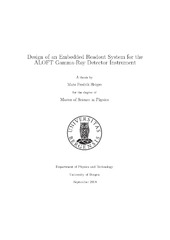Design of an Embedded Readout System for the ALOFT Gamma-Ray Detector Instrument
Master thesis
Permanent lenke
https://hdl.handle.net/1956/18671Utgivelsesdato
2018-10-24Metadata
Vis full innførselSamlinger
Sammendrag
Birkeland Center for Space Science has proposed a campaign known as the Airborne Lightning Observatory for FEGS & TGFs (ALOFT) to study Terrestrial Gamma-Ray Flashes (TGFs). TGFs are the most energetic natural phenomena occurring in the Earth’s atmosphere, and are important to our knowledge about the relationship between the Earth and space. The ALOFT campaign will use a gamma-ray detector instrument built by the University of Bergen which will be mounted to the NASA ER-2 High-Altitude Airborne Science Aircraft. This work covers the design and development of the embedded software used to offload and operate the detector readout system of said instrument. A similar instrument was built and flown in 2017. The new instrument differs from this by being implemented on a System on a Chip (SoC) embedded platform, reusing relevant modules from the old instrument. The software has been implemented with the FreeRTOS Realtime Operating System (RTOS). Design considerations to limit complexity, and the impact of the radiation environment the instrument is to be operated in, has been performed trough implementation of a checksum algorithm, cyclic rewriting of registers, and modular design strategies. A verification system has been realized with a prototype hardware setup, in which test systems has been added to process synthetic TGF-events in the software and hardware. Test with emulated data and a Telnet control interface has been successfully implemented. The current implementation focuses on modularity, and thus offers a very good framework for further development of the instrument when campaign specifications are decided.
